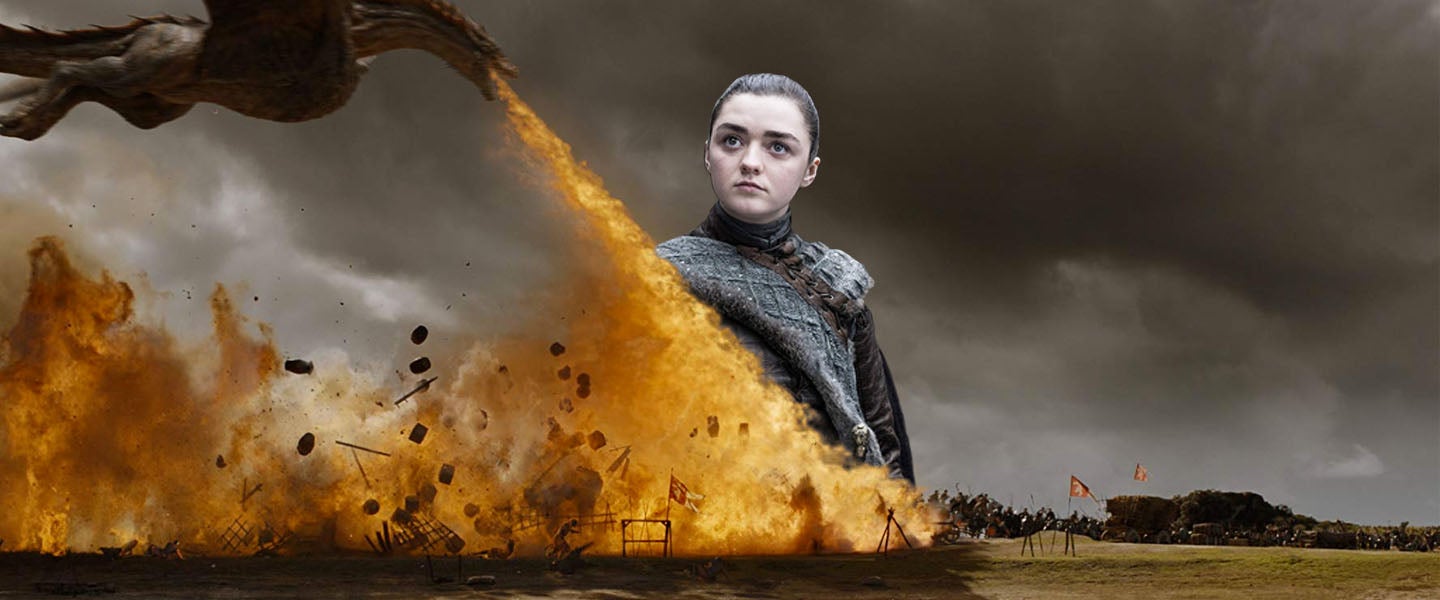In Sunday’s episode of Game of Thrones, the second-to-last of the entire eight-season series, teenage assassin Arya Stark runs through the wreckage of a city scorched by dragonfire, breathing in ash and smoke, losing consciousness amid piles of blackened corpses. She finally escapes, bloodied and coated in soot, with a bad cough.
Grant Reed, a family doctor in central Illinois, is a little worried.
Without knowing the specifics — like how long Arya was knocked out for, or whether most of the smoke exposure was indoor versus outdoor, Reed would guess Arya has “at least mild pneumonitis from the dust exposure.”
He’d get her to a hospital quickly. Arya’s cough “probably has some sputum production, I would assume,” the doctor explains. “If there’s that much soot and dust and crap floating around and you’re unconscious, you’re probably breathing in a considerable amount.”
Yikes. What, exactly, were Arya and the other King’s Landing survivors breathing? What’s really in all that dust?
Basically, Carbon Monoxide…
It depends on the materials of the destroyed buildings. According to Marie Jackson, associate professor of geology and geophysics at the University of Utah, there’s plenty of historical precedent when it comes to the toxins released in burning cities. In this case, we can compare the architecture of King’s Landing to ancient Rome.
“The principal components of ancient Roman buildings are building stone, concrete and wood,” Jackson says. “At high-enough combustion temperatures, compounds like potassium carbonate and calcium carbonate turn to oxides.”
And so, Jackson theorizes, the first chemical to note would be carbon monoxide, “considered the most common, characteristic and serious acute hazard of firefighting.” Based on all the stone, wood and people on fire, carbon monoxide would surely be the No. 1 gas choking people out in King’s Landing.
Dr. Kathleen Dass, an allergist immunologist at the Michigan Allergy, Asthma & Immunology Center, describes what dragonfire smoke would do in the lungs:
“You are inhaling the combustion from the burning fire. This makes your body work harder to breathe, which can lead to hypoventilation and collapse of your airways. Your body will then start to stimulate the nerves in your lungs, which can generate reactive oxygen species — this makes you have dilated blood vessels [and] an increase in inflammatory markers, and thus even more difficulty with breathing. The most common cause of death of inhalation injury is actually carbon monoxide poisoning.”
The nurse in me wanted to assess Arya for inhalation injury and do a STAT carbon monoxide test
— Sable Tapia (@SableTapia) May 13, 2019
…And Calcium Oxide
In addition, assuming King’s Landing sees some rain in the bygone winter season, Jackson explains, with all the destruction happening, there would be another toxic chemical floating around: quicklime.
“Given the right amount of light rain, calcium oxide — or quicklime — slurps carbon dioxide out of the air and forms a crust of essentially CaCO3, the calcite of limestone,” Jackson adds. Quicklime, being so readily available, was often used in ancient warfare as a way to choke and suffocate the other side’s army.
When heated by, say, dragonfire, quicklime decomposes into calcium oxide and carbon dioxide — both of which can lead to asphyxiation. Fun!
Consider King’s Landing’s Already Dismal Air Quality
Jackson says the people of King’s Landing were probably facing some noxious air pollution before Daenerys Targaryen’s dragon arrived.
“There was ongoing indoor and outdoor air pollution in Rome — but not from fires,” she explains. “The residents of ancient Rome referred to their city’s smoke cloud as gravioris caeli (‘heavy heaven’) and infamis aer (‘infamous air’). Several complaints about its effects can be found in classical writings.”
Jackson quotes “the philosopher and statesman” Seneca in A.D. 61:
“No sooner had I left behind the oppressive atmosphere of the city [Rome] and that reek of smoking cookers which pour out, along with clouds of ashes, all the poisonous fumes they’ve accumulated in their interiors whenever they’re started up, than I noticed the change in my condition.”
A Girl Needs an X-Ray
So given the city’s existing air pollution, then mixed with the dust and dragon fire, Jackson concludes Arya is probably in rough shape. “Certainly, considering dust inhalation in working with volcanic stone and volcanic ash and calcined limestone powder… it is not unreasonable to state that both gases and particulate matter from several sources caused health problems.”
Reed, however, is a bit more optimistic. He says Arya’s lack of burn injuries would make him less concerned for smoke-inhalation damage. “If she doesn’t have respiratory distress now, I would doubt it is that serious,” he says.
Thus, the doctor concludes that while there may be some “lingering effects like a cough or wheezing later — especially worse with physical exertion,” he would still tell Arya “to go get her!” — that is, hunt down Daenerys before she can do more damage.
“…But really, I’d probably [listen to her lungs with a stethoscope] and do a chest X-ray, at the very least.”

